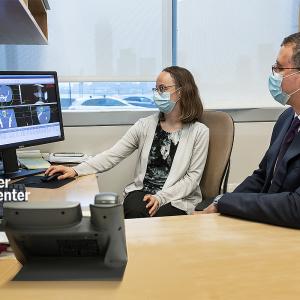
When Sgt. Matthew Zucker tried to pick up a heavy ballistic shield three weeks before his spinal surgery, he had “zero strength” in his right leg. Today, he reports that his strength is back to 100 percent.
Credit: Tony Luong
As a sergeant in the Emergency Service Unit of the New York City Police Department (NYPD), Matthew Zucker, 39, relies on his strong back to carry out many strenuous duties—rope rescues, SWAT team operations, and other high-risk missions that he trains fellow officers to perform. However, for no diagnosed reason, he has suffered from chronic back pain since high school.
In November 2021, when various therapies, including chiropractic manipulation and acupuncture, no longer provided relief, Zucker consulted a pain management specialist. It was then that he found himself in a perilous situation of his own.
An MRI revealed a small mass behind the first lumbar vertebra (L1), located in the lower back. Though Zucker had no symptoms, a follow-up MRI in February 2022 showed that the tumor, now a bit larger than a pea, had grown by 40 percent. Within a week of the test, Zucker’s right leg started feeling weak and numb, the result of pressure the tumor was exerting on nerve roots in his spinal column.
Zucker, who lives with his wife, Katherine, in Long Beach, on Long Island, was connected by the NYPD to two neurosurgeons at NYU Langone Hospital—Long Island: Richard W. Johnson, MD, director of spine neurosurgery, and Lee Tessler, MD, chief of neurosurgery.
Zucker could not have been in better hands. NYU Langone Health spine surgeons perform more than 3,700 surgical procedures each year, with expertise in minimally invasive, robotic, and nonfusion techniques. Their exceptional outcomes, coupled with one of the lowest rates of complications and infection in the nation, are among the reasons NYU Langone is ranked the No. 1 hospital in the nation for neurology and neurosurgery and No. 4 for orthopedics by U.S. News & World Report.
Though indications were that the tumor was benign, Dr. Johnson and Dr. Tessler recommended surgical removal based on Zucker’s age and symptoms and the growth rate of the tumor. “What do you think my odds of getting back to full duty are?” Zucker asked Dr. Tessler.
“We’ll get you back to full duty,” Dr. Tessler replied. It was that confidence, Zucker recalls, that convinced him to proceed. “We wanted to take care of Matthew so that he could continue to take care of all of us,” says Dr. Tessler.
On May 9, 2022, the two subspecialists performed a four-hour surgery in two stages. First, Dr. Johnson, a spine neurosurgeon, carefully created an access corridor through the bony structures of the spine, so that Dr. Tessler, a tumor neurosurgeon, could remove the mass. Dr. Johnson performed a laminectomy, a procedure in which the back of the spine’s bony structure is removed to ease pressure on the spinal cord or nerve roots. In Zucker’s case, Dr. Johnson made a 3-inch-long incision and removed the back portions of three vertebrae.
After pinpointing the location of the tumor in real time using intraoperative ultrasound, Dr. Tessler exposed the nerve roots. Based on the feedback he received from stimulating the nerves, he was able to identify those that control motor function and avoid damaging them. Then, without detaching any nerve fibers, he carefully removed the mass, which was later identified as a schwannoma, a benign primary spine tumor that develops at the nerve root. Schwannomas are rare, affecting fewer than 200,000 people annually in the United States, and they’re even less common in a person Zucker’s age.
Zucker went home two days after surgery and took long walks with his dog, Loki, to aid his recovery. He returned to limited duty three months after surgery and, as Dr. Tessler promised, is now back to full duty. He reports that the strength in his right leg is 100 percent.
“My surgeons did a fantastic job,” Zucker says, “and the results speak for themselves.”

